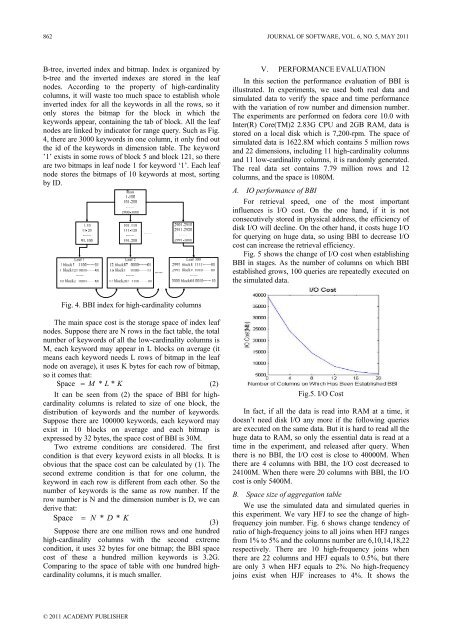Journal of Software - Academy Publisher
Journal of Software - Academy Publisher
Journal of Software - Academy Publisher
Create successful ePaper yourself
Turn your PDF publications into a flip-book with our unique Google optimized e-Paper software.
862 JOURNAL OF SOFTWARE, VOL. 6, NO. 5, MAY 2011<br />
B-tree, inverted index and bitmap. Index is organized by<br />
b-tree and the inverted indexes are stored in the leaf<br />
nodes. According to the property <strong>of</strong> high-cardinality<br />
columns, it will waste too much space to establish whole<br />
inverted index for all the keywords in all the rows, so it<br />
only stores the bitmap for the block in which the<br />
keywords appear, containing the tab <strong>of</strong> block. All the leaf<br />
nodes are linked by indicator for range query. Such as Fig.<br />
4, there are 3000 keywords in one column, it only find out<br />
the id <strong>of</strong> the keywords in dimension table. The keyword<br />
’1’ exists in some rows <strong>of</strong> block 5 and block 121, so there<br />
are two bitmaps in leaf node 1 for keyword ‘1’. Each leaf<br />
node stores the bitmaps <strong>of</strong> 10 keywords at most, sorting<br />
by ID.<br />
Fig. 4. BBI index for high-cardinality columns<br />
The main space cost is the storage space <strong>of</strong> index leaf<br />
nodes. Suppose there are N rows in the fact table, the total<br />
number <strong>of</strong> keywords <strong>of</strong> all the low-cardinality columns is<br />
M, each keyword may appear in L blocks on average (it<br />
means each keyword needs L rows <strong>of</strong> bitmap in the leaf<br />
node on average), it uses K bytes for each row <strong>of</strong> bitmap,<br />
so it comes that:<br />
Space = M * L * K<br />
(2)<br />
It can be seen from (2) the space <strong>of</strong> BBI for highcardinality<br />
columns is related to size <strong>of</strong> one block, the<br />
distribution <strong>of</strong> keywords and the number <strong>of</strong> keywords.<br />
Suppose there are 100000 keywords, each keyword may<br />
exist in 10 blocks on average and each bitmap is<br />
expressed by 32 bytes, the space cost <strong>of</strong> BBI is 30M.<br />
Two extreme conditions are considered. The first<br />
condition is that every keyword exists in all blocks. It is<br />
obvious that the space cost can be calculated by (1). The<br />
second extreme condition is that for one column, the<br />
keyword in each row is different from each other. So the<br />
number <strong>of</strong> keywords is the same as row number. If the<br />
row number is N and the dimension number is D, we can<br />
derive that:<br />
Space = N * D * K<br />
(3)<br />
Suppose there are one million rows and one hundred<br />
high-cardinality columns with the second extreme<br />
condition, it uses 32 bytes for one bitmap; the BBI space<br />
cost <strong>of</strong> these a hundred million keywords is 3.2G.<br />
Comparing to the space <strong>of</strong> table with one hundred highcardinality<br />
columns, it is much smaller.<br />
© 2011 ACADEMY PUBLISHER<br />
V. PERFORMANCE EVALUATION<br />
In this section the performance evaluation <strong>of</strong> BBI is<br />
illustrated. In experiments, we used both real data and<br />
simulated data to verify the space and time performance<br />
with the variation <strong>of</strong> row number and dimension number.<br />
The experiments are performed on fedora core 10.0 with<br />
Inter(R) Core(TM)2 2.83G CPU and 2GB RAM, data is<br />
stored on a local disk which is 7,200-rpm. The space <strong>of</strong><br />
simulated data is 1622.8M which contains 5 million rows<br />
and 22 dimensions, including 11 high-cardinality columns<br />
and 11 low-cardinality columns, it is randomly generated.<br />
The real data set contains 7.79 million rows and 12<br />
columns, and the space is 1080M.<br />
A. IO performance <strong>of</strong> BBI<br />
For retrieval speed, one <strong>of</strong> the most important<br />
influences is I/O cost. On the one hand, if it is not<br />
consecutively stored in physical address, the efficiency <strong>of</strong><br />
disk I/O will decline. On the other hand, it costs huge I/O<br />
for querying on huge data, so using BBI to decrease I/O<br />
cost can increase the retrieval efficiency.<br />
Fig. 5 shows the change <strong>of</strong> I/O cost when establishing<br />
BBI in stages. As the number <strong>of</strong> columns on which BBI<br />
established grows, 100 queries are repeatedly executed on<br />
the simulated data.<br />
Fig.5. I/O Cost<br />
In fact, if all the data is read into RAM at a time, it<br />
doesn’t need disk I/O any more if the following queries<br />
are executed on the same data. But it is hard to read all the<br />
huge data to RAM, so only the essential data is read at a<br />
time in the experiment, and released after query. When<br />
there is no BBI, the I/O cost is close to 40000M. When<br />
there are 4 columns with BBI, the I/O cost decreased to<br />
24100M. When there were 20 columns with BBI, the I/O<br />
cost is only 5400M.<br />
B. Space size <strong>of</strong> aggregation table<br />
We use the simulated data and simulated queries in<br />
this experiment. We vary HFJ to see the change <strong>of</strong> highfrequency<br />
join number. Fig. 6 shows change tendency <strong>of</strong><br />
ratio <strong>of</strong> high-frequency joins to all joins when HFJ ranges<br />
from 1% to 5% and the columns number are 6,10,14,18,22<br />
respectively. There are 10 high-frequency joins when<br />
there are 22 columns and HFJ equals to 0.5%, but there<br />
are only 3 when HFJ equals to 2%. No high-frequency<br />
joins exist when HJF increases to 4%. It shows the

















